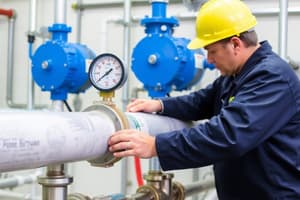Podcast
Questions and Answers
Which of the following is NOT considered a factor affecting piping stress?
Which of the following is NOT considered a factor affecting piping stress?
- Thermal Expansion and Contraction
- Internal Pressure
- Welding Residual Stresses
- Weather Conditions (correct)
Welding residual stresses have no impact on piping stress analysis.
Welding residual stresses have no impact on piping stress analysis.
False (B)
What is the primary load for pressurized piping systems?
What is the primary load for pressurized piping systems?
Internal Pressure
____________ analysis is a widely used numerical method for evaluating piping systems.
____________ analysis is a widely used numerical method for evaluating piping systems.
Match the following analysis techniques to their descriptions:
Match the following analysis techniques to their descriptions:
What does the Stress Intensity Factor (SIF) measure?
What does the Stress Intensity Factor (SIF) measure?
Creep refers to immediate deformation that occurs under high stress.
Creep refers to immediate deformation that occurs under high stress.
What type of failure is caused by repeated cycles of stress?
What type of failure is caused by repeated cycles of stress?
The deformation of pipes due to compressional forces is known as _____
The deformation of pipes due to compressional forces is known as _____
Match the following piping stress analysis outputs with their descriptions:
Match the following piping stress analysis outputs with their descriptions:
Flashcards
Piping stress analysis
Piping stress analysis
The process of evaluating stresses in piping systems caused by pressure, weight, temperature changes, and other loads. It ensures safe and reliable operation.
Internal pressure
Internal pressure
The primary load acting on a piping system, resulting from the fluid inside.
Thermal expansion
Thermal expansion
Changes in pipe length due to temperature variations, which can cause stresses because of expansion and contraction.
Finite element analysis (FEA)
Finite element analysis (FEA)
Signup and view all the flashcards
Design codes and standards
Design codes and standards
Signup and view all the flashcards
Stress Intensity Factor (SIF)
Stress Intensity Factor (SIF)
Signup and view all the flashcards
Pipe Rupture
Pipe Rupture
Signup and view all the flashcards
Creep
Creep
Signup and view all the flashcards
Fatigue
Fatigue
Signup and view all the flashcards
Buckling
Buckling
Signup and view all the flashcards
Study Notes
Introduction to Piping Stress Analysis
- Piping stress analysis is a crucial process in engineering design, ensuring the safety and reliability of piping systems.
- It involves evaluating the stresses developed within piping components due to various internal and external loads.
- Accurate analysis predicts potential failures like cracks, yielding, or fatigue.
- It is essential for compliance with design codes and regulations.
Key Factors Affecting Piping Stress
- Internal Pressure: The primary load for pressurized piping systems.
- External Loads: Weight of piping, equipment, insulation, and soil pressure.
- Thermal Expansion and Contraction: Differences in temperature cause significant expansion and contraction.
- Welding Residual Stresses: Stresses from the welding process, requiring assessment.
- Support Reactions: Reactions at pipe supports due to loads and movements.
- Pipe Movement: Displacement of piping due to thermal growth or other factors.
- Seismic Loads: Crucial for earthquake-prone areas.
- Dynamic Loads: Vibrations or pulsations, often from pumps or compressors.
Methods of Piping Stress Analysis
- Finite Element Analysis (FEA): A numerical method creating a detailed model of the piping system.
- Simplified Hand Calculations: Suitable for simpler systems, based on established formulas.
- Computer-Aided Design (CAD) Software: Used for model development and visualization with analysis software, which often includes piping stress analysis tools.
Key Considerations in Piping Stress Analysis
- Design Codes and Standards: Compliance with standards like ASME B31.3, B31.1, and others is essential.
- Material Properties: Understanding piping material properties (yield strength, tensile strength, modulus of elasticity).
- Corrosion Allowance: Assessing corrosion impacts on the pipe.
- Fabrication and Installation: These factors can induce stresses and affect the system’s performance.
- Safety Factors: Applying safety margins for unforeseen circumstances.
- Fatigue Analysis: Identifying areas prone to fatigue failures due to repeated stress cycles.
- Defect or Damage Tolerance (or Crack Growth Analysis): Evaluating pipe integrity in the presence of assumed defects.
- Stress Intensity Factor (SIF): A measure of stress near a crack tip.
Common Piping Stress Problems
- Pipe Rupture: Failure due to excessive stresses from pressure or other factors.
- Creep: Deformation over long periods under sustained stress.
- Fatigue: Failure due to repeated stress cycles.
- Buckling: Local or global deformation due to compressional forces or moment.
Stress Analysis Output Interpretation
- Stress Concentration: Identifying high-stress points.
- Stress Ranges: Determining the maximum and minimum stress experienced by the pipeline.
- Stress Ratios: Evaluating calculated stress against allowable stress levels.
- Deflection or Displacement: Quantifying pipe movement.
- Support Reactions: Determining force requirements on support elements.
Piping Stress Analysis Software
- Commercial software packages for piping stress analysis are available. These include tools for FEA, hand calculations, and visualization.
- Expertise is needed for effective tool use and reliable results.
- Data import and analysis reporting are crucial steps.
Conclusion
- Piping stress analysis is critical for safe and reliable piping systems.
- Thorough understanding of factors and analysis methods is essential.
- Proper application of codes, standards, and software is crucial for successful analysis.
Studying That Suits You
Use AI to generate personalized quizzes and flashcards to suit your learning preferences.




